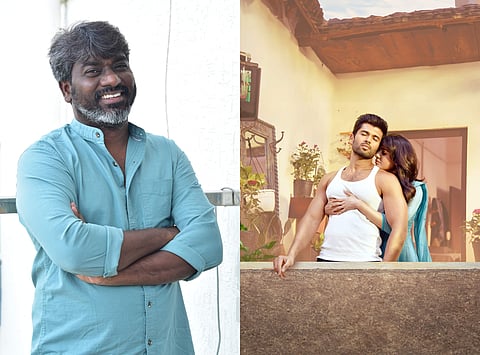

Cinematographer G Murali drops in a serendipitous anecdote about his relationship with Kushi’s male lead Vijay Devarakonda in the middle of the press interaction. “Not many people know this but we go way back. I was assigned as the cinematographer for his supposed debut around 2012. We worked closely through the pre-production process, only to see the project eventually get shelved. Then there was another project we were supposed to work on together, that did not materialise as well. Finally, we started working together in Kushi. Even though our project did take off, we had to stop midway and postpone our film’s release by eight months. I don’t know whether that is a good or bad but here are the series of coincidences that shaped our dynamic,” says Murali, laughing, while making his fondness for Vijay evident. The coincidental nature of Murali’s personal equation with Vijay is conversely complimented by the randomness characteristic of his professional trajectory.
Hailing from the hamlet of Uthanagarai in the Krishnagiri district of Tamil Nadu, Murali comes from a family of elementary school teachers. “But the funny thing is, the children of teachers are ironically least interested in studies. At least that was the case with me,” notes Murali, who later goes on to say that he first learned music for two years, before transitioning to a five-year course in the Kumbakonam Fine Arts College, after which he moved to Pune to pursue a three-year diploma in cinematography from the prestigious Film and Television Institute Of India. The cinematographer goes on to phrase his chaotic yet diverse journey with a couple of poeticisms. “Music has the ability to evoke imagery even when you close your eyes. But when I actually began to paint more, I was spurred by the urge to bring motion to paintings and visuals. That is how I moved to cinematography. I was not someone who went around clicking pictures for fun before deciding to make a living out of it.”, says Murali.
The cinematographer has made his mark in the world of cinema through his collaborations with acclaimed writer-director Pa Ranjith, with whom he has worked in Madras, Kabali, Kaala, and Sarpatta Parambarai. Kushi is Murali’s sophomore foray into the Telugu film industry, having previously worked in the Hanu Raghavapudi directorial Andala Rakshasi, which was also incidentally Murali’s first feature. The differences between his work in Tamil cinema and his latest release Kushi is not lost on Murali. Commenting on them, he says, “I am personally more inclined towards socially conscious cinema with a gritty, realistic tone. But romantic films are a different ballgame. You do not merely shoot things as you see them. There is also an element of authentic emotion that translates into fantasy, and it is our job as cinematographers to project that abstractness onto the screen. This was a new experience for me, I had to change the way I think for Kushi and lean into that fantasy.”
Kushi is choc-a-bloc with Mani Ratnam references, with director Shiva Nirvana going as far as to make his protagonist Lenin Viplav (Vijay Devarakonda) a self-proclaimed fan of his. How much did the film’s overall proclivity towards the auteur translate into the film’s cinematography, considering Mani Ratnam’s films are held as a benchmark for visual finesse? Murali comments that the director’s collaborations with PC Sreeram (Alaipayuthey, OK Kanmani, Geethanjali, Thiruda Thiruda) were an inspiration for Team Kushi from the get-go. “That said, we carefully trod the line between inspiration and replication, making all due efforts to not fall into the latter category. Considering this is a Telugu film, the sensibilities do lean more on the commercial side. Shiva Nirvana came forth with some mainstream inputs, I balanced that out in the back end with my realistic perspectives. At the end of the day, the film’s bright and colorful visuals do not merely exist to make a film bankable. I want it to liven up people’s hearts and I have tried my best to make Kushi more accessible and relatable in that regard.”
Talking more about PC Sreeram and how cinematography has come a long way since the 90s, Murali says, “It was the first time any one of us saw people clap in the theatres when they saw the cinematographer’s name. PC Sreeram made cinematography so dramatic and exciting. But things are not so dramatic anymore. PC’s style itself toned down by the time he came around to shooting Cheeni Kum. People’s tastes have changed. When we use a round track, audience will laugh at us commenting, ‘oh why is the camera going round and round’. The medium has adapted, and so have we, the people behind it.”
Murali has been selective throughout his career, working in a handful of films over the last eighteen years. Commenting on the same, he notes, “I don’t see this as a business. Plus I like to be hands-on with my films, involving myself closely from the film’s nascent stages to its final ones.” Having passed on his frequent collaborator mantle to his former assistant A Kishor Kumar, who has gone on to work with Pa Ranjith in Natchathiram Nagaragiradhu and his upcoming film Thangalaan, Murali has now set his sights upon direction, admitting that he is writing a few scripts at the moment. “That is my ultimate goal. From music, I moved to painting, and from painting, I shifted to cinematography. My next destination in this pursuit of authentic artistic expression is direction,” quips Murali.